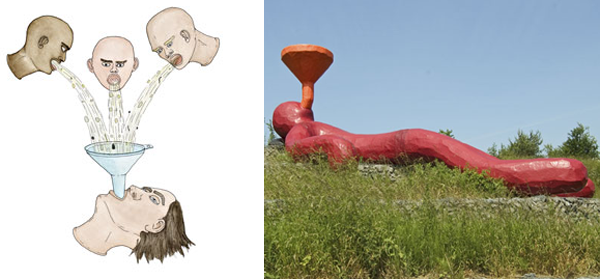Taste as communication
February 17th, 2009Tags: collision, communication, taste, vap
this post is part of the class 4.366/4.397 Networked Cultures: Collision - Body vs. Network

Atelier van Lieshout’s Funnel Man
Food has always been prominently depicted in art, and since the 50s it has also commonly been used as a material. Daniel Spoerri’s Eat Art and Dieter Roth’s salami or chocolate paintings use food to consider the decay of art. Wim T. Schippers, Job Koelewijn and Wim Delvoyes used peanut butter, pasta and cold cuts respectively to adorn gallery floors over the course of 30 years. Food is consumable, temporal and necessary for human survival. Taste is closely linked to food, but can it be used as a message as well as a by effect of eating?
Erin E. Elliott presented an edible interface in 2006. She placed a photo resistor in a lollipop, which was used as a button in various button-mashing races and games. The concept of using an edible element to control an otherwise flavourless system is humorous: Kyle Macdonald used Skittles to control a beat sequencer, Daneil Maynes-Aminzade (aka Monzy) used jelly beans to track CPU activity; but none of these works use taste as the message, but instead use food as a tool.
To be able to use taste as a communication system, it needs to be conveyed as a message. Taste must be recognised, propagated and reproduced. Electric tongues are in development which use both chemical sensors and mechanical sensors to extract flavours of a liquid. The ‘tongue’ has also been repackaged into a spoon, which allows the user to remotely sense the temperature and saltiness of a liquid. If the flavour can be broken down into a mix of basic flavour components, a recipe could be sent over a network and an object such as the (albeit jokingly introduced) TasteScreen could be used to reproduce the message.
But no great efforts are being made to network flavours, possibly because flavour has not yet been assigned any communicative value. Instead, flavours and texture are mapped to words when the flavour itself must be communicated. A collection of mappings of flavours and textures to words was used in Ted Selker’s group at the Media Lab to create a highly personalised recipe finder inspired by synaesthesia, but the synaesthetic portion of the work was kept mainly in the title.
